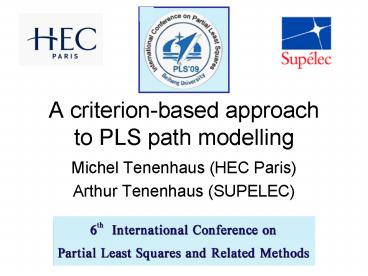A criterionbased approach to PLS path modelling - PowerPoint PPT Presentation
1 / 29
Title:
A criterionbased approach to PLS path modelling
Description:
Economic inequality and political instability Data from Russett (1964), in GIFI ... FARM : % farmers that own half of the land ( 50) RENT : % farmers that rent ... – PowerPoint PPT presentation
Number of Views:63
Avg rating:3.0/5.0
Title: A criterionbased approach to PLS path modelling
1
A criterion-based approachto PLS path modelling
- Michel Tenenhaus (HEC Paris)
- Arthur Tenenhaus (SUPELEC)
PLS09
2
Economic inequality and political instability
Data from Russett (1964), in GIFI
- Economic inequality
- Agricultural inequality
- GINI Inequality of land distributions
- FARM farmers that own half of the land (gt
50) - RENT farmers that rent all their land
- Industrial development
- GNPR Gross national product per capita (
1955) - LABO of labor force employed in agriculture
- Political instability
- INST Instability of executive (45-61)
- ECKS Nb of violent internal war incidents
(46-61) - DEAT Nb of people killed as a result of civic
group violence (50-62) - D-STAB Stable democracy
- D-UNST Unstable democracy
- DICT Dictatorship
3
Economic inequality and political instability
(Data from Russett, 1964)
4
A SEM model
Agricultural inequality (X1)
INST
GINI
ECKS
C13 1
FARM
?1
DEAT
RENT
?3
C12 0
D-STB
GNPR
D-INS
?2
C23 1
LABO
DICT
Industrial development (X2)
Political instability (X3)
4
5
Latent Variable outer estimation
6
Some modified multi-block methods for SEM
cjk 1 if blocks are linked, 0 otherwise and cjj
0
GENERALIZED CANONICAL CORRELATION ANALYSIS
GENERALIZED PLS REGRESSION
7
Covariance-based criteria for SEM
cjk 1 if blocks are linked, 0 otherwise and cjj
0
8
A continuum approach
9
Construction of monotone convergent algorithms
for these criteria
- Construct the Lagrangian function related to the
optimization problem. - Cancel the derivative of the Lagrangian function
with respect to each wi. - Use the Wolds procedure to solve the stationary
equations (? Gauss-Seidel algorithm or ? MAXDIFF
algorithm). - This procedure is monotonically convergent the
criterion increases at each step of the algorithm.
10
The general algorithm
Iterate until convergence of the criterion.
11
Specific cases (All ?i 0)
PLS Mode B
12
Specific cases (All ?i 1)
With usual PLS regression constraint
PLS New Mode A
13
Specific cases (Mixing ?j 0 and ?k 1)
13
14
I. PLS approach 2 blocks
()
() Deflation Working on residuals of the
regression of X on the previous
LVs in order to obtain orthogonal LVs.
15
II. Structural Equation Modeling
Agricultural inequality (X1)
INST
GINI
ECKS
FARM
?1
DEAT
RENT
?3
D-STB
GNPR
D-INS
?2
LABO
DICT
Industrial development (X2)
Political instability (X3)
16
SABSCOR-PLSPMMode B Centroid scheme
(XLSTAT-PLSPM software)
Y1 X1w1
Y3 X3w3
Y2 X2w2
? One-step hierarchical CCA
17
SSQCOR-PLSPMMode B Factorial scheme
(XLSTAT-PLSPM software)
Y1 X1w1
Y3 X3w3
Y2 X2w2
? One-step hierarchical CCA
18
Comparison between methods
gt
lt
Practice supports theory
19
Usual Mode A Centroid schemeXLSTAT-PLSPM
software
The criterion optimized by the algorithm, if any,
is unknown.
19
20
SABSCOV-PLSPMNew Mode A Centroid
scheme(Arthurs R-program)
weight
0.66
Cor.429
0.17
0.74
Cov1.00
0.44
0.11
0.50
-0.55
Cov-1.69
0.69
0.46
Cor-.764
-0.72
? One-step hierarchical PLS Regression
20
21
SABSCOV-PLSPMNew Mode A Factorial
scheme(Arthurs R-program)
weight
0.66
Cor.4276
0.17
0.74
Cov1.00
0.44
0.10
0.48
-0.56
Cov-1.69
0.69
0.49
Cor-.7664
-0.72
? One-step hierarchical PLS Regression
21
22
Generalized Barker Rayens PLS-DASSQCOV-PLSPMNe
w Mode A for X1 and X2 and Mode B for Y
? One-step hierarchical BR PLS-DA
23
Generalized Barker Rayens PLS-DA
Industrial development
Agricultural inequality
24
III. Multi-block data analysis
SABSCOR PLS Mode B Centroid scheme
Use of XLSTAT-PLSPM
25
Multiblock data analysis
SSQCOR PLS Mode B Factorial scheme
26
Practice supports theory
gt
lt
(checked on 50 000 random initial weights)
27
IV. Hierarchical model J blocs
. . .
28
Conclusion 1
- In the PLS approach of Herman Wold, the
constraint is - In the PLS regression of Svante Wold, the
constraint is - This presentation unifies both approaches.
29
Conclusion 2Comparison between methods
- PLS path modelling (with Horst, centroid or
factorial schemes) is closer to multi-block data
analysis than to SEM. PLS uses only links
between blocks to compute the components. - Generalized Structured Component Analysis (GSCA)
is closer to SEM than to multi-block data
analysis. GSCA uses the structural equations to
compute the components. - Consider also using McDonald ULS-SEM to compute
block components. Very efficient for practical
applications. - When all blocks are good (? uni-dimensionnal),
all methods give practically the same components.
29































